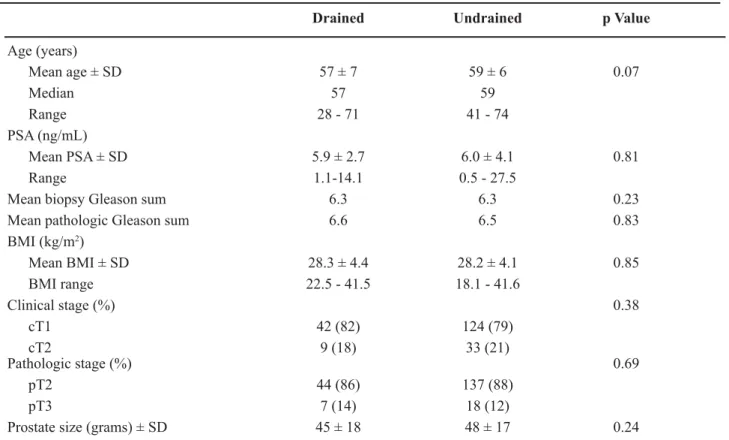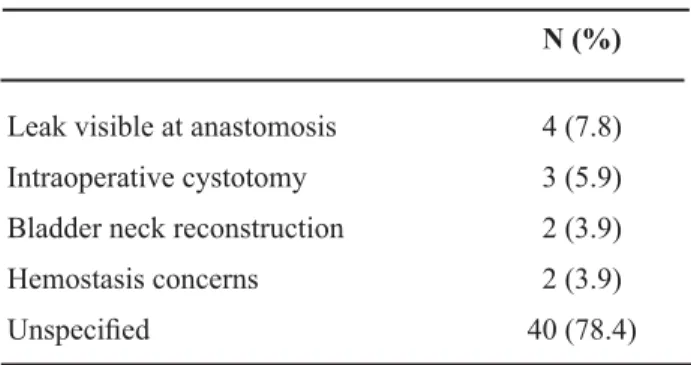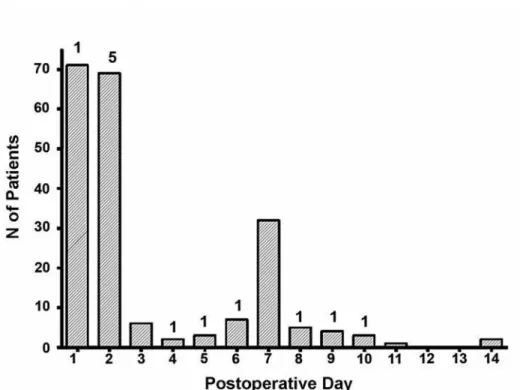Laparoscopic Radical Prostatectomy: Omitting a Pelvic Drain
David Canes, Michael S. Cohen, Ingolf A. Tuerk
Lahey Clinic Medical Center, Burlington, Massachusetts, USA
ABSTRACT
Purpose: Our goal was to assess outcomes of a selective drain placement strategy during laparoscopic radical prostatectomy (LRP) with a running urethrovesical anastomosis (RUVA) using cystographic imaging in all patients.
Materials and Methods: A retrospective chart review was performed for all patients undergoing LRP between January DQG'HFHPEHU7KHDQDVWRPRVLVZDVSHUIRUPHGXVLQJDPRGL¿HGYDQ9HOWKRYHQWHFKQLTXH$GUDLQZDVSODFHG at the discretion of the senior surgeon when a urinary leak was demonstrated with bladder irrigation, clinical suspicion for a urinary leak was high, or a complex bladder neck reconstruction was performed. Routine postoperative cystograms were obtained.
Results:208 patients underwent LRP with a RUVA. Data including cystogram was available for 206 patients. The overall rate of cystographic urine leak was 5.8%. A drain was placed in 51 patients. Of these, 8 (15.6%) had a postoperative leak on cystogram. Of the 157 undrained patients, urine leak was radiographically visible in 4 (2.5%). The higher leak rate in WKHGUDLQHGYVXQGUDLQHGFRKRUWZDVVWDWLVWLFDOO\VLJQL¿FDQWS 7ZHQW\IRXUSDWLHQWVXQGHUZHQWSHOYLFO\PSK node dissection (8 drained, 16 undrained). Three undrained patients developed lymphoceles, which presented clinically on average 3 weeks postoperatively. There were no urinomas or hematomas in either group.
Conclusions: Routine placement of a pelvic drain after LRP with a RUVA is not necessary, unless the anastomotic integrity is suboptimal intraoperatively. Experienced clinical judgment is essential and accurate in identifying patients at risk for postoperative leakage. When suspicion is low, omitting a drain does not increase morbidity.
Key words: prostatectomy; urinoma; laparoscopy; complications; drainage; surgical anastomosis
Int Braz J Urol. 2008; 34: 151-8
INTRODUCTION
Acceptance of the laparoscopic radical prostatectomy (LRP) since its inception, and later its robotic counterpart, has been motivated by a drive to minimize perioperative morbidity. Room for improvement still exists, with the hope that minor technical adjustments will further decrease morbidity. The following editorial remark accompanies a 1996 article addressing the morbidity of drains following radical retropubic prostatectomy (RRP): “anything
that reduces patient discomfort deserves consider ation” (1).
6DYRLHHWDO¿UVWVXJJHVWHGDSHOYLFGUDLQ
prostatectomy. We hypothesized that improved optical
PDJQL¿FDWLRQDQGDUXQQLQJXUHWKURYHVLFDODQDVWRPR
sis (RUVA) may obviate routine pelvic drainage. We assessed the relationship between pelvic drainage and postoperative complications in a consecutive series of 268 LRP in which routine postoperative cystography was performed in all patients, regardless of drain status.
MATERIALS AND METHODS
Laparoscopic radical retropubic prostatec tomy (LRP) was performed on 268 patients at the Lahey Clinic Medical Center between January 2003 and December 2004. Two hundred and eight patients
ZHUHLGHQWL¿HGLQZKRPDQ589$ZDVSHUIRUPHG &RPSOHWHSUHRSHUDWLYHRSHUDWLYHDQGSRVWRSHUDWLYH
patient information was obtained from a combina tion of a prospective database maintained by the Department of Urology Clinical Research Assistants
DQGIURPDUHWURVSHFWLYHFKDUWUHYLHZ7KHDJHFR PRUELGLWLHVSURVWDWHVSHFL¿FDQWLJHQ36$*OHDVRQ
score, clinical stage, estimated blood loss, blood transfusions, pelvic lymph node dissection (PLND),
SDWKRORJLFDOVWDJHSDWKRORJLFDO*OHDVRQVFRUHSURV
tate size, intravenous narcotic use, length of stay, and complications were recorded. The body mass index (BMI) was calculated from the preoperative height and weight documented in the anesthesia report. The operative time was calculated from incision start time to procedure end time as recorded in the opera tive nursing report. Narcotic use was calculated to be the sum of intravenous narcotics recorded by the nursing staff and administered via patient controlled analgesic or on an as needed basis. Different narcotics
PHGLFDWLRQVZHUHFRQYHUWHGWRPRUSKLQHHTXLYDOHQWV
for comparison.
All patients underwent either a transperito neal or extraperitoneal LRP as described previously (5,6) by a single surgeon (IT). When nerve sparing was indicated and technically feasible, this was
SHUIRUPHGXVLQJDKDUPRQLFVFDOSHO(WKLFRQ(QGR
Surgery). Lymphadenectomy included the external iliac and obturator lymph nodes. The anastomosis
ZDVSHUIRUPHGZLWKWZRPRQRFU\OVXWXUHVHDFK ZLWKDSRO\GLR[DQRQHDEVRUEDEOHVXWXUHFOLS/DSUD
TyTMRQRQHHQG7KH¿UVWVXWXUHZDVSODFHGDWWKH SRVLWLRQDQGUXQQLQJVWLWFKHVZHUHPDGH
in the counterclockwise direction. The second suture
ZDVSODFHGDWWKHSRVLWLRQDQGUXQQLQJ
stitches made in the clockwise direction. Therefore, prior to cinching the sutures, at least 4 to 6 running stitches were placed. Therefore, the initial tension is
GLVWULEXWHGRYHUVWLWFKHVLQVWHDGRI7KHQWKH
sutures were continued in a running manner in their appropriate direction until they meet at the anterior aspect of the anastomosis and tied together with an intracorporeal knot.
Anastomotic integrity was tested by distend ing the bladder with approximately 200 mL of saline,
SULRUWRLQÀDWLQJWKH)ROH\EDOORRQ$-DFNVRQ3UDWW
closed suction or Penrose drain was placed at the discretion of the senior surgeon (IT) when a leak was visualized at the anastomosis or a complex bladder neck reconstruction was performed. Indications for drain placement were obtained from the operative report. When omitted from the operative report, the
LQGLFDWLRQZDVUHFRUGHGDVXQVSHFL¿HG7KHGUDLQZDV
placed in close proximity to the anastomosis. If drain
DJHZDVOHVVWKDQFFSHUKRXUVKLIWWKHGUDLQZDV
removed. A routine cystogram was performed within
WKH¿UVWSRVWRSHUDWLYHGD\VLQRISDWLHQWV7KH
remaining patients had a cystogram prior to postop
HUDWLYHGD\32'GXHWRVFKHGXOLQJGLI¿FXOWLHV
Patients were seen postoperatively at 1 week, 5 weeks, 3 months, 6 months, 9 months, and 1 year in
IROORZXS7KH)ROH\FDWKHWHUZDVUHPRYHGRQ32' LIWKHF\VWRJUDPVKRZHGQRHYLGHQFHRIOHDNGH¿QHG
as any amount of contrast extravasation. Patients were
DVNHGDVHULHVRITXHVWLRQVWRVFUHHQIRUV\PSWRPDWLF LQWUDDEGRPLQDOFROOHFWLRQVDQGFRPSOHWHDEGRPLQDO
examination was performed. Directed radiographic imaging was performed when warranted by clinical symptoms. The primary endpoint was the incidence of early postoperative complications: urine leak, uri noma, lymphocele, and hematoma.
)LVKHU¶VH[DFWWHVWZDVXVHGWRDQDO\]HWKHDV
sociation between categorical data: (1) urine leak and drain placement, (1) urine leak and surgical approach, and (3) drain placement and performance of PLND.
7ZRWDLOHGSYDOXHVZHUHUHSRUWHG8QSDLUHGWWHVW
DJH36$ELRSV\*OHDVRQSDWKRORJLF*OHDVRQ%0,
prostate size, operative time, estimated blood loss,
PRUSKLQHHTXLYDOHQWVXVHGDQGOHQJWKRIVWD\7KH FKLVTXDUHWHVWZDVXVHGWRFRPSDUHWKHGLVWULEXWLRQRI
clinical and pathologic stage between both groups.
RESULTS
A total of 208 patients underwent LRP with a RUVA between January 2003 and December 2004.
The drained and undrained groups did not differ with
UHVSHFW WR DJH SUHRSHUDWLYH 36$ ELRSV\ *OHDVRQ VXPSDWKRORJLF*OHDVRQVXP%0,FOLQLFDOVWDJH SDWKRORJLFVWDJHRUSURVWDWHVL]H7DEOH
7KHRSHUDWLYHDQGSRVWRSHUDWLYHGDWDGHP RQVWUDWHGDVWDWLVWLFDOO\VLJQL¿FDQWGLIIHUHQFHEHWZHHQ
the drain and undrained groups in regards to operative
WLPHSRVWRSHUDWLYHQDUFRWLFXVHDQGOHQJWKRIVWD\ 7DEOH+RZHYHUWKHUHZDVQRVWDWLVWLFDOGLIIHU
ence in estimated blood loss between groups. When a drain was placed, operative time was longer by an
Table 1 – Patient, tumor characteristics.
Drained Undrained p Value
Age (years)
Mean age ± SD 57 ± 7 59 ± 6 0.07
Median 57 59
Range
PSA (ng/mL)
Mean PSA ± SD 5.9 ± 2.7 6.0 ± 4.1 0.81
Range
0HDQELRSV\*OHDVRQVXP 6.3 6.3 0.23
0HDQSDWKRORJLF*OHDVRQVXP 6.6 6.5 0.83
BMI (kg/m2)
Mean BMI ± SD 28.3 ± 4.4 28.2 ± 4.1 0.85
BMI range
Clinical stage (%) 0.38
cT1 42 (82) 124 (79)
cT2 9 (18) 33 (21)
Pathologic stage (%) 0.69
pT2 44 (86) 137 (88)
pT3 7 (14) 18 (12)
Prostate size (grams) ± SD 45 ± 18 48 ± 17 0.24
BMI = body mass index; SD = standard deviation.
Table 2 – Operative and postoperative data.
Drained Undrained p Value
Operative time (min) ± SD 186 ± 32 169 ± 23 < 0.0001 Estimated blood loss (mL) ± SD 158 ± 92 174 ± 119 0.38
0RUSKLQHHTXLYDOHQWV6' 32.0 ± 21.0 17.2 ± 17.8 < 0.0001
DYHUDJHRIPLQXWHV&,S < 0.0001). Postoperative narcotic use and average length of
VWD\ZHUHVLJQL¿FDQWO\JUHDWHUZKHQFRPSDULQJWKH
drained and undrained groups, respectively. In the majority of cases, the indication for drain placement
ZDVQRWVSHFL¿HGLQWKHRSHUDWLYHUHFRUG7DEOH
Reasons stated for drain placement included the fol lowing: visible leak during testing of the anastomosis, inadvertent cystotomy during bladder neck dissection, extensive bladder neck reconstruction, and concerns
IRUKHPRVWDVLV7DEOH
The incidence of urinary extravasation on
SRVWRSHUDWLYH F\VWRJUDP LV RXWOLQHG LQ7DEOH
Drains were placed in 51 patients (25%), and omitted in 157 (75%). Cystograms were available for 206 pa tients (99%). Mean duration of drainage was 48 hours. Overall, 12 patients had radiographic evidence of a urinary leak (5.8%). The patients with a drain had a statistically higher incidence of a urinary leak. Pres
HQFHRIUDGLRJUDSKLFXULQHOHDNZDVQRWVLJQL¿FDQWO\ DVVRFLDWHGZLWKVXUJLFDODSSURDFKS HLWKHU WUDQVSHULWRQHDOQ OHDNVRUH[WUDSHULWRQHDO Q OHDNV$VVKRZQLQ)LJXUHRI SDWLHQWVKDGSRVWRSHUDWLYHF\VWRJUDPVZLWKLQWKH¿UVW
7 postoperative days; the remainder were performed the following week. As expected, earlier cystograms demonstrate the majority of leaks, with 50% seen on
32'RU$OOOHDNVUHVROYHGRQIROORZXSLPDJ
ing after prolonged drainage. No patient developed a urinoma in this series.
2I WKH SDWLHQWV QRQQHUYH VSDULQJ
unilateral nerve sparing, and bilateral nerve spar ing procedures were performed in 21 (10.1%), 55 (26.4%), and 126 (60.6%) patients. Nerve sparing data was missing in 6 (2.9%) patients. There were no postoperative bleeding complications, includ
LQJKHPRUUKDJHRUKHPDWRPD1RSDWLHQWUHTXLUHG
intraoperative or postoperative blood transfusion,
RUUHRSHUDWLRQIRUEOHHGLQJ2QHSDWLHQWUHTXLUHGD
secondary procedure for anastomotic urine leak. This patient had mild unilateral hydronephrosis and a clini
FDOOHDNZLWKLQFUHDVLQJGUDLQRXWSXW+HUHWXUQHGWR
the OR on POD 7 for ureteral stent and suprapubic catheter placement. Of note, had cystograms not been performed in any patient, this is the only patient whose leak was apparent from increased pelvic drain output. The remaining 11 patients with a radiographic leak had no increased drainage.
Three patients underwent laparoscopic lym phocele fenestration. Their lymphoceles (12.5% of
Table 3 – Indications for drain placement.
N (%)
Leak visible at anastomosis 4 (7.8)
Intraoperative cystotomy 3 (5.9)
Bladder neck reconstruction 2 (3.9)
+HPRVWDVLVFRQFHUQV 2 (3.9)
8QVSHFL¿HG 40 (78.4)
Table 4 – Complication rates, PLND status.
Drained Undrained Total p Value
Total number of patients 51 157 208
Cystogram performed 51 155 206
Cystographic leak (%) 8 (15.6) 4 (2.5) 12 (5.8) 0.002
Resolved with prolonged catheterization 7 4 11
Second procedure for drainage 1 0 1
Urinoma 0 0 0
PLND performed 8 16 24 0.32
Lymphocele 0 3 (18.8) 3 (12.5)
Lap lymphocele fenestration 0 3 (18.8) 3 (12.5)
patients undergoing PLND) presented on average 3
ZHHNVSRVWRSHUDWLYHO\ZLWKV\PSWRPVRIORZJUDGH
fever, urinary retention with bladder spasms, or lower extremity edema. Of the patients undergoing PLND in whom drains were omitted, the approach was ex traperitoneal in 14/16 (87.5%). Drain placement was
QRWVLJQL¿FDQWO\DVVRFLDWHGZLWKWKHSHUIRUPDQFHRI 3/1'S
COMMENTS
The Miami group, who were the first to suggest that routine pelvic drainage after open RRP was unnecessary (2,3) placed drains with a similar selective strategy. Since their report, the Roswell Park group has also supported the safety of drain omission (7). These reports relied on global compari sons of complication rates, without imaging studies.
7KHSUHVHQWVWXG\LVWKH¿UVWWRRXUNQRZOHGJHLQ
which routine postoperative cystograms were used to assess the true radiographic leak rate underlying this clinically driven algorithm, adding to a growing body of literature to support selective drain omission.
Using this selective algorithm, drains were placed in
RISDWLHQWVDSSUR[LPDWHO\WKHVDPHIUHTXHQF\
as prior reports (2,7). The overall cystographic leak
UDWHGH¿QHGDVDQ\UDGLRJUDSKLFH[WUDYDVDWLRQLQWKLV
series is 5.8% and objective imaging was available for 99% of patients. Interestingly, only one of the ten patients with radiographic evidence of a leak had a clinical leak.
What is the correlation between clinical and radiographic impressions of water tightness? Ischia and Lidsay, in a study of 68 patients undergoing open prostatectomy, found a strong correlation between intraoperative assessment with saline instillation,
DQGVXEVHTXHQWORZOHDNUDWHRQF\VWRJUDP2XWRI
68 consecutive patients, 53 had no intraoperative leakage, and of these only two (3.7%) had leaks on day 7 cystograms (8). Our data are similar, in that unsuspected leaks in the undrained group occurred in only 4 patients (2.5%).
Our overall cystographic leak rate compares favorably with published series. Cystography data has generally been analyzed to assess the feasibility of early catheter removal, and to correlate leak rates with the occurrence of anastomotic strictures. Studies often
have inconsistent reporting (clinical vs. radiographic leak rate) and discrepant testing intervals. Leibovitch
HWDOIRXQGRISDWLHQWVZLWKVLJQL¿FDQWFRQWUDVW
extravasation in a consecutive series of 245 patients
XQGHUJRLQJRSHQ553+RZHYHUPLQLPDORUFRQ
tained extravasation was observed in an additional 11.4%, for a total leak rate of 17.1% (9). Cystography was performed late (19.2 days postoperatively) com pared to the current study.
&RQWUDVWH[WUDYDVDWLRQLQWKH¿UVWGD\V
postoperatively has historically been reported to
UDQJHIURP6LPLODUVWDWLVWLFVKDYHIX
eled conventional wisdom that early extravasation was common following open RRP. Dalton et al. (10) reported a leak rate of 34.5% in a series of 55 patients studied with cystograms starting on day 7. Ramsden et al. reported a 31% leak rate in 275 consecutive open RRP cases where cystography was performed between postoperative days 8 and 10 (11). Contemporary num
EHUVDUHPXFKORZHU*XD]]RQLHWDOUHSRUWHGD
leak rate on postoperative day 5 cystograms in patients undergoing LRP with an interrupted anastomosis (12). In another review of 619 open RRP with cystograms at day 10 a leak rate of 4.6% was reported (13), which
LVVLPLODUWRRXU¿QGLQJV
Even when timing of cystography and anas
WRPRWLFWHFKQLTXHDUHVLPLODUOHDNUDWHVPD\GLIIHU
Nadu et al. reported the only other series of LRP with a RUVA in which cystography was routinely performed (14). A cystographically apparent leak was present in 17/113 patients (15.1%), even though most parameters mirror our series. The RUVA was performed with a
VLQJOHSRO\JODFWLQVXWXUH&\VWRJUDPVZHUHSHU IRUPHGEHWZHHQSRVWRSHUDWLYHGD\V1RXULQRPDV
developed, and drain status was not reported. What accounts for the higher leak rate? Patients were asked to Valsalva during cystography, which may transmit greater pressures to the anastomosis, whereas patients are imaged while voiding without Valsalva at our institution.
+R]QHN HW DO ZHUH WKH ¿UVW WR GHVFULEH D 589$ZKLFKKDVVLJQL¿FDQWO\GHFUHDVHGRSHUDWLYH WLPHDQGHI¿FLHQF\GXULQJWKLVSRUWLRQRIWKHSURFH
dure (15). The difference in early integrity between
UXQQLQJ DQG LQWHUUXSWHG WHFKQLTXHV LV QRW NQRZQ
Theoretically, suture tension may be distributed more evenly over the circumference of the anastomosis.
Authors have assumed, based on lack of symptomatic urine leak, that the anastomosis is watertight (16). Our cohort includes the learning curve for the RUVA, as well as objective imaging. Therefore, a low leak rate of 5.8% lends further evidence to this clinical obser vation. Although a selective drain placement strategy may be appropriate when a laparoscopic interrupted
DQDVWRPRWLFWHFKQLTXHLVHPSOR\HGRXUVWXG\GLG QRWLQFOXGHSDWLHQWVZLWKWKLVWHFKQLTXHQRUZDVLW GHVLJQHGWRFRPSDUHGLIIHUHQWDQDVWRPRWLFWHFKQLTXHV
We also noted that although the senior surgeon had performed several hundred LRP prior to this time period, this cohort contains his learning curve for the RUVA. We have previously reported that a low leak rate may be a good surrogate endpoint for advanced
DFTXLVLWLRQRIWHFKQLFDOVNLOO
,QWXLWLYHO\DVHQLRUVXUJHRQ¶VMXGJPHQWRI
anastomotic integrity should be accurate, and objec tive imaging substantiates this impression. When
DGUDLQZDVSODFHGWKHOHDNUDWHZDVVLJQL¿FDQWO\
higher. When the anastomosis was watertight intraop eratively and a drain omitted, the leak rate was indeed
VLJQL¿FDQWO\ORZHUEXWQRW]HUR)RXUSDWLHQWVLQWKH
undrained group did have leaks, none of which devel oped into urinomas. The longer operative time in the
GUDLQHGJURXSZDVVWDWLVWLFDOO\VLJQL¿FDQW+RZHYHU
we did not conclude that placing a drain led to a statistically longer operative time. In the majority of
FDVHVWKHUHDVRQIRUGUDLQSODFHPHQWZDVQRWVSHFL¿HG
A narrow pelvis or otherwise small working space,
¿EURWLFEODGGHUQHFNWLVVXHSUHVHQFHRIDPHGLDQ OREHRUDGLI¿FXOWSRVWHULRUGLVVHFWLRQIURPSUHYLRXV
prostatitis may all contribute a sense of complexity to
SHUIRUPLQJD/537KHVHIDFWRUVDUHOHVVTXDQWL¿DEOH
and translate into prolonged operative time. Since indications for placement were neither prospective nor randomized, selection bias of the senior surgeon is inherent in this study. That this bias has statistically
VLJQL¿FDQWFOLQLFDOXWLOLW\KRZHYHULVDQLPSRUWDQW ¿QGLQJ
Traditionally, drains are placed to allow the
HJUHVVRIXULQHEORRGDQGO\PSKDWLFÀXLG&OLQL FDOVXVSLFLRQZDVVXI¿FLHQWWRRPLWDGUDLQZLWKRXW
increasing the chance of urinoma. Symptomatic lymphoceles were also acceptably uncommon (3/24 PLND). Since PLND was performed in only 24
UHJDUGLQJGUDLQDJHIROORZLQJ3/1'+RZHYHURXU
data suggests that lymphoceles should generally not
EHXVHGDVDMXVWL¿FDWLRQIRUGUDLQSODFHPHQW/\P
phoceles in this series became symptomatic 3 weeks postoperatively. Lymphoceles therefore accumulate
ORQJDIWHUWKHSHOYLFGUDLQKDVEHHQUHPRYHG)ULHG
et al. observed a similar time course, where two symptomatic lymphoceles occurred at 4 and 9 weeks postoperatively (18). Pepper et al. reported a series of 260 open RRP with PLND in which 9 patients
GHYHORSHGO\PSKRFHOHVGD\VSRVWRS
eratively (19). The mean time at diagnosis was not provided.
In general, the lymphocele rate after open
3/1'LVEHWZHHQ7KHZLGHUDQJH GHSHQGVRQWKHVXUJLFDOWHFKQLTXHXVHGDQGZKHWKHU
clinical or radiographic diagnostic triggers are
HPSOR\HG)UHLGHWDOUHSRUWHGFOLQLFDOO\GHWHFWHG
lymphoceles in 1% of 111 patients, although 7/23
ZKRVXEVHTXHQWO\XQGHUZHQW&7LPDJLQJ
for adjuvant radiation had lymphoceles (18). The approach, whether transperitoneal or extraperitoneal,
DOVRFRQWULEXWHV:LWKWKHIRUPHUO\PSKDWLFÀXLGLV
absorbed, compared to an extraperitoneal approach where the retropubic space is an enclosed area where any lymphatic drainage can readily form a lympho
FHOH+RZHYHURXUGDWDVXJJHVWVWKDWGUDLQDJHLVQRW
mandatory even after PLND and an extraperitoneal approach. Of the 16 patients undergoing PLND with out postoperative drainage, 87.5% were approached extraperitoneally and only 3 developed symptomatic lymphocele. A larger study with power to address this
TXHVWLRQLVQHHGHGEHIRUHGH¿QLWLYHUHFRPPHQGDWLRQV
can be made.
The morbidity of the drain itself is not a primary endpoint of this study. The drained group utilized more narcotic medication than the undrained group. We cannot conclude that the increased pain was
DWWULEXWDEOHWRWKHGUDLQ:LWKRXWGLUHFWHGTXHVWLRQ
naires and pain score assessment, the contribution of drains to increased narcotic use is speculative. Evi dence for drain related pain was reported by Niesel et al., who found that roughly one out of every four patients experience pain after RRP attributable only to the drain site and not the incision (1). The longer length of stay in the drained group is also likely mul tifactorial. The single patient with a clinical urine
leak had an 11 day hospital stay, which may have contributed to the increased mean length of stay in the drained group.
In addition to the retrospective, nonrandom ized nature of this study, a potential criticism is the
UROHRIWKHF\VWRJUDPLWVHOILQVXEVHTXHQWGHFLVLRQ PDNLQJ +HUH RI OHDNV ZHUH RQO\ DSSDUHQW
radiographically, and prolonged catheterization and repeat imaging were performed. Can the cystogram itself be omitted? At the present time, after the results of the present study and with increased experience, we have ceased performing routine cystography. Us ing this selective drain algorithm we have found no increased incidence of complications.
CONCLUSIONS
Routine pelvic drainage has traditionally ac companied radical prostatectomy. Our results suggest a pelvic drain can be omitted in patients undergoing an LRP with a RUVA if the anastomosis is watertight intraoperatively. Incidence of clinically detected urine leak, urinoma, hematoma, and lymphocele is not increased with this selective strategy.
CONFLICT OF INTEREST
None declared.
REFERENCES
1. Niesel T, Partin AW, Walsh PC: Anatomic approach for placement of surgical drains after radical retropubic SURVWDWHFWRP\ ORQJWHUP HIIHFWV RQ SRVWRSHUDWLYH SDLQ8URORJ\
2. Savoie M, Soloway MS, Kim SS, Manoharan M: A pelvic drain may be avoided after radical retropubic SURVWDWHFWRP\-8URO
3. Araki M, Manoharan M, Vyas S, Nieder AM, Soloway MS: A pelvic drain can often be avoided after radical UHWURSXELFSURVWDWHFWRP\DQXSGDWHLQFDVHV(XU 8UROGLVFXVVLRQ
7UDEXOVL (- *XLOORQQHDX % /DSDURVFRSLF UDGLFDO SURVWDWHFWRP\-8URO
WHFKQLTXH-(QGRXUROGLVFXVVLRQ 604.
6WRO]HQEXUJ-8'R05DEHQDOW53IHLIIHU++RUQ L, Truss MC, et al.: Endoscopic extraperitoneal radical prostatectomy: initial experience after 70 procedures. -8URO
6KDUPD6.LP+/0RKOHU-/5RXWLQHSHOYLFGUDLQ DJHQRWUHTXLUHGDIWHURSHQRUURERWLFUDGLFDOSURVWD WHFWRP\8URORJ\
8. Ischia JJ, Lindsay S: Is a cystogram necessary after UDGLFDOSURVWDWHFWRP\"$1=-6XUJ /HLERYLWFK,5RZODQG5*/LWWOH-6-U)RVWHU56
Bihrle R, Donohue JP: Cystography after radical retro pubic prostatectomy: clinical implications of abnormal ¿QGLQJV8URORJ\
'DOWRQ'36FKDHIIHU$-*DUQHWW-(*UD\KDFN-7 Radiographic assessment of the vesicourethral anas tomosis directing early decatheterization following QHUYHVSDULQJUDGLFDOUHWURSXELFSURVWDWHFWRP\-8URO
5DPVGHQ$5&KRGDN*:&DQOHDNDJHDWWKHYHVLFR urethral anastomosis be predicted after radical retro SXELFSURVWDWHFWRP\"%-8,QW *XD]]RQL*&HVWDUL$1DVSUR55LYD0&HQWHPHUR
$=DQRQL0HWDO,QWUDDQGSHULRSHUDWLYHRXWFRPHV comparing radical retropubic and laparoscopic radical prostatectomy: results from a prospective, randomised, VLQJOHVXUJHRQVWXG\(XU8URO
9DUNDUDNLV-:LUWHQEHUJHU:3LQJJHUD*0%HUJHU$ +DUDED\DVKL7%DUWVFK*HWDO(YDOXDWLRQRIXULQDU\ H[WUDYDVDWLRQDQGUHVXOWVDIWHUFRQWLQHQFHSUHVHUYLQJ radical retropubic prostatectomy. BJU Int. 2004; 94:
1DGX$6DORPRQ/+R]QHN$2OVVRQ/(6DLQW)GH La Taille A, et al.: Early removal of the catheter after laparoscopic radical prostatectomy. J Urol. 2001; 166:
+R]QHN$6DORPRQ/5DELL5%HQ6ODPD05&LFFR A, Antiphon P, et al.: Vesicourethral anastomosis dur ing laparoscopic radical prostatectomy: the running VXWXUHPHWKRG-(QGRXURO 9DQ9HOWKRYHQ5)$KOHULQJ7(3HOWLHU$6NDUHFN\
':&OD\PDQ597HFKQLTXHIRUODSDURVFRSLFUXQQLQJ urethrovesical anastomosis: the single knot method. 8URORJ\
17. Cohen MS, Canes D, Tuerk IA: Secondary learning curve for the laparoscopic radical prostatectomy. J Urol. 2006; 175: (Suppl. 4): 367.
)UHLG506LHJHO'6PLWK$':HLVV*+/\PSKR celes after laparoscopic pelvic node dissection. Urol RJ\$6XSSO
19. Pepper RJ, Pati J, Kaisary AV: The incidence and treatment of lymphoceles after radical retropubic SURVWDWHFWRP\%-8,QW
Accepted after revision: January 9, 2008
Correspondence address: Dr. David Canes
Lahey Clinic Medical Center 41 Mall Road


